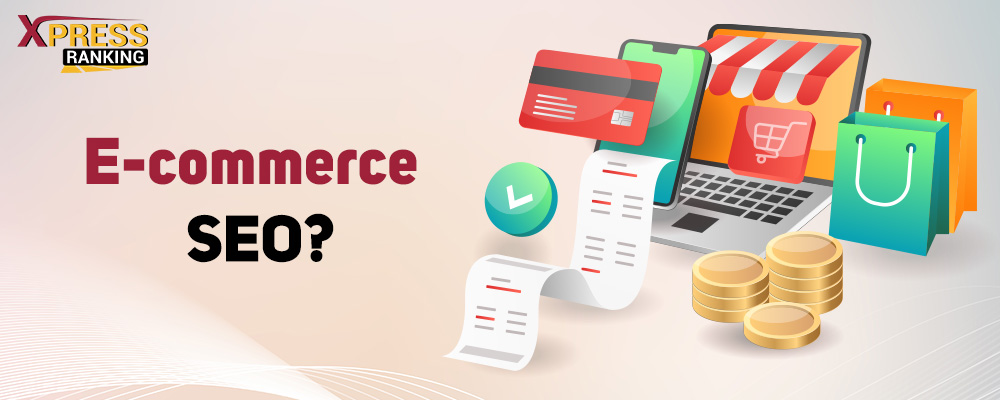Undoubtedly, Search Engine Optimization (SEO) has proven to be a secret sauce for all types of website success, and it is no different for E-commerce sites. If you’re retailing products and want to expand globally, and reach a wider audience, then you must get your E-commerce website optimized for SEO.
Why so? Well, E-commerce SEO helps you understand the basics about your customers, for example, how people search for what you sell and other demographic details like their age group, location, and behavioral pattern. By using the tracking method, you can leverage your customer’s data for behavioral analysis to get to know them even better.
Actually, Ecommerce SEO can do more than that. It can help you understand where you went wrong. For example, technical issues, traffic sources that don’t work, offers that don’t appeal, and cart abandonment issues and their potential causes. Above all, the more obvious reason you will want to have your E-commerce website SEO fully optimized is the growth of E-commerce worldwide. According to studies, Ecommerce keeps on growing, and hopefully, this pattern will likely continue. It’s great if you are already online. However, if you don’t take proactive steps to increase your reach, then you might remain invisible to fresh prospects and new leads.
And how do you take proactive steps? Well, it’s simple. Optimize your E-commerce site for SEO.

What is E-commerce SEO?
SEO is a strategy used by Ecommerce businesses to rank at the top position of SERPs like Google and Bing. An E-commerce website that is well-designed and optimized with high-quality content will rank better in search engines, increasing the online store’s visibility and driving traffic as compared to sites that aren’t optimized for SEO. In simple words, when you optimize your Ecommerce website for SEO, you are strong enough to drive maximum leads and conversions.
However, it’s important to note that SEO for E-commerce differs from SEO for content-focused websites. E-commerce SEO is more than just adding keywords, writing blog posts, and gaining links. It’s important to understand how search engines work and what they reward for. This implies having a working knowledge of SEO for Ecommerce, along with considering Google’s guidelines, analyzing buyer intent, and implementing it strategically.
E-commerce SEO best practices
With millions of online retail sites out there, it’s not always easy to make your site stand out, but it’s also not impossible! You can make a positive start by applying some best practices. With the right strategies in place, you can increase your chances of visibility and gain more organic leads and customers over time.
For the newbie, best practices for E-commerce SEO looks like this:
- Navigation
- Internal links
- Avoiding clutter
- Creating unique content
- Including alt text for images
You can start by addressing these fundamentals. Below is a list of SEO for E-commerce best practices:
1. Implement proper keyword research
Relevant and strategic use of keywords on your site can be a game changer in ranking your website on the SERPs. All sites are different, though, and not every approach is suitable for every site or product. However, some guidelines apply to every online retailer, and one of them includes performing keyword research correctly. While it’s necessary to use the most relevant and popular keywords in your industry, you must also understand buyer intent.
Buyer intent or keyword intent is the intention behind a search query. You can identify it by paying attention to the specific phrases and terms people use when looking for information online.
2. Optimize product pages to improve the ranking.
Optimizing your product pages is the key to attracting and acquiring new customers. It helps push your website to secure the top position in the search engine, meaning fresh streams of organic traffic and more conversions.
However, it’s important to note that not every area of your Ecommerce site needs optimizing. So here we will focus on the ones that matter most to online retailers: product descriptions and images.
Product descriptions: The product page is interesting as it consists of many listed products and their unique features. All you want is to make your product descriptions stand out, so it intrigues visitors to get started with the buying process. So what can you do to maximize the impact of your product description?
- Add multiple, high-quality, unique images.
- Include keywords
- Include detailed, keyword-rich descriptions
- Add call to action
- Include testimonials
Images: Images are an excellent way to communicate a message and draw in an audience. However, it is often the most neglected area of SEO for E-commerce. Here are some pointers for optimizing your images:
- Choose suitable images for your platform
- Provide captions with alt tags for pictures.
- Use the right keywords in file names.

3. Make sure your website is user-friendly.
Enhanced user experience is achieved when the Ecommerce website has a good design, aesthetics, and visual appeal. While a good-looking website is crucial, it’s also important that your website works well. User experience includes everything from navigation, ease of use, and the overall ‘feel’ of the website. Users who land on your website should be able to easily find what they are looking for, keeping them engaged while browsing and giving visitors the best experience possible. According to a study, if Google thinks your website offers visitors a bad experience, it may rank lower. This implies that UX (User Experience) can be a Google ranking factor.
There are many factors that can influence UX:
- Ads shouldn’t interfere with the user’s view of content.
- The site must load quickly and be mobile-friendly.
- The website should be clutter-free and easy to navigate.
- CTAs must be present so customers know what to do next.
4. Don’t forget long-tail keywords.
Long-tail keywords generally appear on the right side of a search engine results page (SERP). It is a term that typically has low search volume but still meets the criteria for relevance to your business. They are a better match for what the people are looking for and usually give higher keywords. For those reasons, you must use long-tail keywords because they are a valuable source of traffic. Long-tail keywords are great for:
- Competitive niches
- Increased conversation rates
- Ranking new sites more easily.
5. Avoid duplicate pages and content.
Have you ever scrolled through a website and got a feeling that you are reading the same thing on every page? That’s the issue with most of the E-commerce website’s product catalogs and category descriptions. Online retailers usually duplicate product catalogs and images, and it’s understandable why. It’s generally because they don’t have the resources to produce fresh content.
Even if you don’t rewrite everything, it’s important to reduce the amount of duplication on your site in product descriptions and other areas like:
- Use different product images
- Add unique keywords on other pages
- Add suffix to the URL
Bottom line
SEO is a vital tool for Ecommerce to boost website visibility, bring new queries and customers, and also build a loyal audience. By having the main SEO best practices at your fingertips and optimizing the critical areas of your website, you can boost your Ecommerce website.



